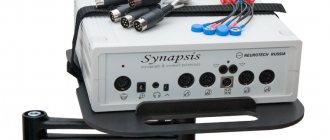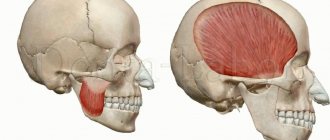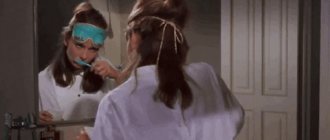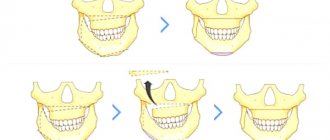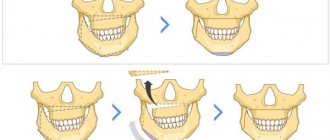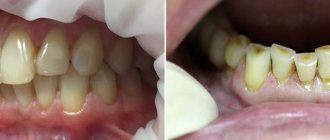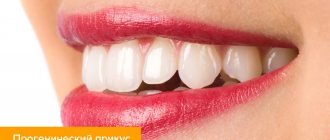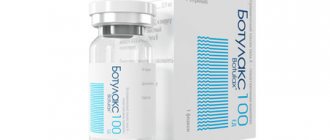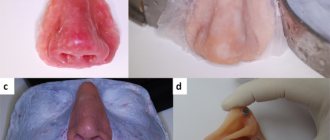- Jaw muscle spasm
- Development of the disease
- Symptoms of TMJ problems
- Diagnostics
- Prevention of hypertonicity of the TMJ muscles
- Prevention of hypertonicity of the TMJ muscles
Spasm of the jaw muscles is called trismus, and can be single or multiple.
The jaw muscles are always toned (in background activity, ready for action). Muscle hypertonicity represents increased activity and tension, with decreased ability to stretch. With mild hypertonicity, a person experiences slight discomfort. In the case of moderate or severe hypertonicity, muscle spasm occurs, accompanied by pain. In difficult cases, the jaw cramps so that the person cannot open the jaw. Muscle spasm under the jaw
there is one-sided and two-sided
There are several causes of jaw muscle spasm. Common causes may be internal diseases of an infectious or neurological nature:
- Neoplasms in the brain of benign and malignant nature.
- Intracranial hemorrhage.
- Meningitis.
- Diseases of the nervous system (stress, depression).
- Tetanus, rabies.
- Anatomical tissue defects.
Local causes are diseases of the maxillofacial area and injuries:
- Inflammatory process of bone tissue (osteomyelitis).
- Cellulitis and abscess.
- Inflammatory process in the soft tissues around wisdom teeth.
- Inflammation of the periosteum.
- Unsuccessful anesthesia during dental surgery on the lower jaw.
- Dislocation, fracture or crack in the lower jaw.
- Arthrosis or arthritis of the TMJ.
- Inflammatory process in the trigeminal nerve.
- Hypothermia or overload of the lower jaw.
- Periodontitis or pulpitis in an advanced stage.
- Incorrect installation of the bracket system or poor-quality prosthetics.
- Sports injuries (common in boxers who use mouthguards, weightlifters who clench their teeth while lifting weights, scuba divers who use an oxygen tank mouthpiece for long periods of time).
It is important to consult a dentist so that he can diagnose such a multifaceted disease as spasm of the jaw muscles.
The dentist will be able to find out the reasons after examination, history taking, and diagnostics.
Development of the disease
A provoking factor appears that causes a single muscle tension. Constant hypertonicity gradually develops into spasm. Pain weakens the muscle over time as the person tends to use the muscle less. The result is a decrease in muscle tone
. Against this background, compensatory tension of the muscle located on the opposite side of the jaw develops.
With muscle pain syndrome, the patient experiences constant pain in the area of the masticatory muscles, which intensifies with movement of the lower jaw. When closing and opening the jaws, a clicking sound is heard in the TMJ. Visually, zigzag deviations of the jaw to the side or forward are observed. Bruxism develops
. Sometimes pain syndrome manifests itself in the upper jaw, sinuses, superciliary arches, and ringing or noise in the ears develops.
General information
The shape and outline of the lower part of the face depend on the relative position of the jaws, the state of the masticatory muscles, and the shape of the lower jaw, which is attached to the skull with the help of ligaments and muscles.
Chewing teeth are the only support of the lower jaw (which is in a suspended state), which fix its position on the face. When the correct arrangement of the dentition changes or teeth are lost, the spatial position of the jaw also changes.
With most malocclusions, the lower third of the face drops, and coordination of the temporomandibular joint (TMJ) and the muscles responsible for chewing is disrupted. Bruxism (involuntary teeth grinding) and oromandibular dystonia (uncontrollable muscle spasms in the lower jaw and mouth) cause the jaw muscles to contract violently. Because of this, their hypertrophy occurs, which manifests itself externally in a “square face” and the massiveness of the lower part of the face.
Symptoms of TMJ problems
The disease manifests itself with the following symptoms:
- Painful sensations occur on palpation.
- When opening the mouth, the patient feels a sharp pain.
- Due to pain, a person experiences difficulty eating and communicating.
- Breathing through the mouth is difficult.
- To the touch, the chewing muscles are compacted and slightly increased in volume.
- Facial asymmetry with unilateral spasm.
- Low-grade fever.
- Headache.
The gnathologist
carries out differential diagnosis with a fracture or dislocation of the jaw, as well as with an infectious lesion.
There are three degrees of disease progression: mild (the patient is able to open his mouth four centimeters), moderate (the mouth opens two centimeters), severe (the patient cannot open his mouth more than one centimeter).
Ways to strengthen facial muscles at home
You can delay irreparable changes and keep your facial muscles toned in different ways: use traditional medicine recipes, special gymnastics, or seek help from specialists.
To achieve visible results, regularity and comprehensiveness of measures are important. A one-time cosmetic procedure will not restore elasticity to the skin, and exercise for 2-3 months does not guarantee a toned face until old age.
The most accessible and effective way to tighten the oval face is special gymnastics.
Facebook building
The “face building” program was created by a plastic surgeon for his beloved lady in order to maintain a youthful and elastic face. Carol Maggio further popularized the set of exercises in her book, which captivated the world.
The main postulate of the system is that the facial muscles need training along with the body muscles. Smiles and grimaces are not enough to maintain healthy skin and elasticity of muscle fibers. The neck, chin, cheekbones and nasolabial triangle require special exercises.
Important! You should always start gymnastics by warming up the muscles. Stroke the skin along the massage lines, ensuring blood flow to the face, warm up the muscles with active articulation.
Basic exercises:
- Take air into your cheeks and smoothly move it from left to right. Repeat 30 times. It is allowed to take breaks, as it is difficult to perform without stopping.
- Fill your cheeks again with air and move it around in a circle. Repeat also at least 30 times. As air passes over and under your lips, through your cheeks, hold for five seconds.
- To tighten sagging skin on your neck and get rid of a double chin, do the following: open your mouth slightly and move your head back. Then close your mouth, feeling the tension in your chin. Return to the starting position. Repeat up to 50 times.
- Pinch the corners of your lips with your fingers, and try to push your lower jaw forward. Count to 10 and then relax. Repeat at least 15 times.
- For the nasolabial area, do the following: place your index fingers at the corners of your lips and stretch them back to the starting position. Perform at least 40 times. Then form your lips into a tube and, as you exhale, say “oo-oo,” round your lips and say “oo-oo.”
Attention! The first results will be noticeable after two weeks of training. The blood supply to the facial skin will improve, a healthy glow will appear, elasticity will increase and fine wrinkles will disappear.
With regular exercise, women notice a more noticeable effect after 1-2 months.
Massage
You can independently help your skin in the fight against age-related changes with the help of a classic massage. Pre-cleanse your skin of cosmetics and prepare a cream or oil, for example, apricot kernels for dry skin and jojoba oil for oily skin. For normal skin, olive oil is suitable, and for eyelids - almond oil.
The basic rule of the procedure is to make movements only along special lines: from the center of the forehead to the temples, from the nose to the ears, from the corners of the mouth to the earlobes, from the inner to the outer eyes in a circle. You need to make movements smoothly and with stroking.
Only in the chin area is it permissible to tap with the outside of the palm.
If you have doubts about the correctness of actions, contact a specialist. For noticeable results, you need to visit a cosmetologist at least 10 times. From a salon procedure you can expect a tightening of the contour, a reduction in swelling, and a smoothing of wrinkles.
Plastic massage or Jacquet massage with deep impact is recommended to be done only in the salon, as pinching and pressing are expected.
Diagnostics
The patient experiences pain from jaw movement. In this situation, it is necessary to consult a doctor as soon as possible to begin treatment. It is necessary to find out how to relieve jaw muscle spasm in order to restore health.
During the examination and history taking, the doctor observes the patient, paying attention to his posture and head tilt, neck movements, facial expressions, and facial expressions. The state of the muscles during speaking and swallowing is determined. The presence of the corneal reflex is checked, and the amplitude of movements of the lower jaw is determined. The doctor finds out whether there are problems with the spine.
The patient is examined using diagnostic equipment, an occlusiogram is prescribed to determine the type of bite, and its dynamics and statics are measured. If necessary, an X-ray of the TMJ and an orthopantomogram of the jaws are prescribed, and an electromyographic study is performed.
I have hypertonicity of the facial muscles: what should I do?
Relax. The most affordable and effective solution is self-massage of the facial muscles, aimed at reducing muscle tone. A study conducted by Revitonica employees proved that in just 2.5 months of regular self-massage of the face and neck gymnastics, hypertonicity decreases by 22–55%. Which means it's time to act!
On our YouTube channel we often publish useful techniques for the face and neck. Watch, remember - and apply!
Prevention of hypertonicity of the TMJ muscles
Preventive measures against hypertonicity of the lower jaw muscles will help prevent the disease with an integrated approach. It is much easier to follow the general recommendations of doctors than to face a painful spasm of the TMJ. Prevention includes the following activities:
- Preventive visits to the doctor every six months.
- Careful systematic oral hygiene.
- Treatment of caries at its first symptoms.
- Orthodontic treatment for malocclusion pathologies.
- Disinfection of food products.
- Antitetanus therapy for animal bites.
- A set of necessary vaccinations.
- Do not open your mouth wide (jaw dislocations often occur when trying to bite off a large fruit).
- Do not overuse solid foods and do not chew nuts with your teeth.
- Avoid stressful situations, react less to stress.
[Un]attainable ideal
Ideally, the muscle fiber should work like a spring: compress when the nerve endings command “come on!”, and then relax and return to its original position.
But muscle hypertonicity changes everything! Spring muscles contract or stretch - and remain in a tense state. They can no longer relax on their own.
Hypertonicity of the facial muscles is the main cause of facial wrinkles and creases, swelling, sunken cheeks, and loss of proportions. It can be measured using special equipment - an electromyograph. And it can be determined by appearance and subjective sensations. Frequent signs of hypertonicity are numbness of the face in the cold, grinding of teeth, harsh facial expressions, an exhausted, tired appearance, eyebrows constantly shifted to the bridge of the nose.
Tight muscles drive themselves into a trap: they squeeze blood vessels, blood with oxygen and nutrients stops flowing to the muscle fiber - and the muscles simply atrophy.
Consequences of jaw spasm
Trismus is unpleasant for a person not only due to pain. When opening and closing the mouth is painful, the normal process of eating is disrupted and the gastrointestinal tract suffers. When the jaw spasms, breathing is impaired, which leads to constant oxygen starvation of the brain and headaches. This affects the composition of the blood and the functioning of the cardiovascular system.
Trismus caused by infections or tumors causes serious health problems. In this case, long-term serious treatment is required. In the initial stages, pain is completely relieved. For systemic diseases, when trismus is a secondary symptom, complex therapy is necessary.
Hypertonicity in infants
In 90 cases out of 100, children in the first months of life experience increased muscle tone. There are two main causes of this condition in infants:
- physiological characteristics;
- disturbances in the functioning of the central nervous system.
In the first case, the baby’s muscle tone is explained by the fact that during intrauterine life the child was in a limited, small space of the mother’s uterus and his posture was forcedly constrained, the so-called fetal position. The arms and legs of the fetus are pressed to the body, and the chin to the chest. After birth, this position is the most familiar and safe for the baby, the baby needs to get used to the new world around him, usually by 3 months the muscles gradually relax, and the increased tone goes away on its own, without the need for treatment. However, if hypertonicity persists after 3 months, this may indicate that the baby’s nervous system has been damaged. The main causes of hypertension in children older than 3 months lie in the influence of negative factors during the period of intrauterine development of the fetus, diseases, and birth injuries. It could be:
- bad habits of the expectant mother: smoking, alcohol, drugs;
- infectious diseases suffered by the mother during pregnancy, or her chronic diseases;
- early or late toxicosis of the pregnant woman, uterine tone, threat of miscarriage;
- Rhesus conflict between mother and fetus;
- perinatal encephalopathy;
- rapid or prolonged labor;
- fetal hypoxia in utero or during childbirth;
- various birth injuries.
Typically, neurologists prescribe procedures for children with increased muscle tone that can only relieve the main symptoms, but they do not find the causes of the disorders and do not solve the problems. For example:
- physiotherapy;
- physiotherapy;
- aromatherapy;
- massotherapy;
- drug treatment.
The most effective method of treating hypertension in young children is osteopathic. An osteopathic doctor views the human body as a single whole, and sees all its systems and organs as interconnected. Osteopaths can treat one organ while influencing another, identifying the cause of the pathology and combating its consequences. Osteopathic treatment is based on a special massage. The doctor's fingers are extremely sensitive and receptive, and movements and manipulations are very soft and gentle. That is why the effects of osteopathic techniques on infants are safe, painless and effective. An osteopath can easily help a child’s nervous system, which is not fully formed, to function fully.
Skin care tips
In addition to gymnastics and massage treatments, it is important to properly care for the delicate skin of the neck and face.
- Every day, tone your skin with ice cubes made from herbal infusion. This will give your face a fresh look and blush. Ice perfectly prevents facial wrinkles.
- When using the cream, do not rub it on the skin or stretch it. It is much more effective to apply the cosmetic product with your fingertips using patting movements.
- Do not rub your face with a towel after washing, pat lightly - this will be enough.
